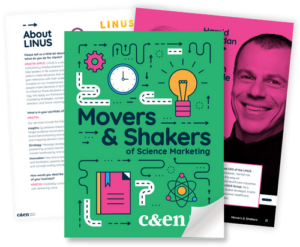The COVID-19 pandemic dramatically changed the way we live and work. For marketing, public relations and advertising agencies, there have been a range of operational and logistical challenges as agencies and clients navigate uncharted waters. As part of ACS Media Group’s Movers & Shakers project, we spoke to a panel of industry experts about the lasting pandemic impact on science marketing. Read below to learn how COVID-19 has forever changed the industry and the new trends it’s sparked.
A Digital Marketing Transformation

One of the pandemic’s most significant and immediate industry impacts was the suspension of in-person events and sales visits. Chris Lawson, director and co-founder of Orientation Marketing, says COVID-19 shined a light on the industry’s reliance on face-to-face events.
“We had several new clients contact us simply because there was no ‘Plan B,’ said Lawson. “From a lead generation perspective, they did not really know what to do to replace the opportunities that physical events provided them.”
This shift caused marketers to reevaluate their methods and quickly implement more modern digital tactics. Paul Avery, co-founder of BioStrata, said this sparked a digital marketing transformation. Companies that have been putting off modernizing their websites, CRM and marketing automation systems decided to invest.
Lasting Impact on Events and Lead Generation
Even as events have largely returned, companies must balance both in-person and digital tactics. Surging COVID cases, budgets and environmental impact considerations will keep some clients seeking digital alternatives to in-person events. There is no sign of a digital slowdown. Kate Whelan, COO and head of Notch Scandinavia predicts that the digital landscape will only become more competitive. “If companies are not matching the marketing activity levels of their competitors, they will be left behind,” said Whelan. “Internally, across all client accounts, we are seeing this trend play out.”
eMarketer predicts B2B digital ad spend will reach $18.47 billion by 2024. That amount will account for 50% of total ad spending that year. But that doesn’t mean in-person tradeshows and conferences are a thing of the past. “The marketing industry has always been a land of extroverts,” said Erik Clausen, managing partner of CG Life. “While I do truly believe that people in our industry can do the work from anywhere, we are better at what we do when we’re interacting with one another in real live places and environments.”
Shifting Norms Provide Challenges and Opportunity
As with all industries, the pandemic forced science marketers to adjust to new demands and schedules. Working from home, embracing new technologies, and trying to balance home schooling and childcare with workloads caused many in the industry to reevaluate how to maintain work/life balance.
One consensus between agencies was that remote or hybrid work models are here to stay and have their own perks. “We’re recruiting the best talent from all over the world and no longer limited by the cities in which we have a physical office presence,” said Dillon Allie, president and chief executive officer at HDMZ.
But these loosened geographical constraints also apply to employees. This means agencies must be more competitive to attract and keep top talent. In 2021, opportunity-seeking and pandemic burnout ushered in the ‘Great Resignation’ causing quit rates to reach a 20-year high.
“We implemented a number of benefits to attract and retain talent during the past two years,” said CG Life’s Clausen. “In addition to our awesome workplace and culture, new offerings include professional education reimbursement, paid sabbaticals, 401K match, highly competitive compensation set by external review of compensation models in the marketplace, merit raises, swag, and more.”
CG Life isn’t alone. Many agencies have boosted their benefits packages since the pandemic. These new benefits often focus on personal-investment and well-being. Kristin Apple, president of LINUS Group, said her company gives team members a stipend to spend on wellness activities. This can range from a ski pass, new running shoes, annual National Parks pass, or subscription to a wellness-related app.
Silver Linings Point to Bright Future for Science Marketers
There’s no denying that COVID-19 has left a devastating impact on our society. If there is one silver lining to be found, Clausen says it could be renewed faith and understanding of science. “This is a wonderful by-product of an ugly period in the world. I firmly believe there will be a generation coming up who will not only understand and pursue science, but will also champion it,” said Clausen. “This might be our only shot at adapting to climate change and avoiding the next global pandemic or other threats that we don’t even see around the next corner.”
Following some initial drops in business at the start of the pandemic, the agencies we spoke to largely experienced growth over the past two years, signaling an influx of investment in science and demand for marketing in the space.
Hamid Ghanadan, founder and CEO of the LINUS Group, said one positive pandemic trend he predicts (and hopes) will stick around is increased communication between brands and their audiences. “When social distancing limited the companies’ main customer touchpoint of sales visits, organizations became far more willing to participate in two-way communication, which generated tremendous brand loyalty,” said Ghanadan. “In our surveys of scientists about how the pandemic affected their work, many respondents expressed gratitude for the effort that supplier companies were making to stay connected.”
As we close in on three years since the start of the pandemic, one thing is clear: the need for good, honest, and impactful science marketing has never been greater. Clare Russell, co-founder of BioStrata said, “I feel lucky to be part of that community, where I can help facilitate change and further the incredible developments and technologies that are driving progress across our planet in some of the most exciting areas of technology and medicine.”
Download the eBook for More
Get more insights on how the COVID-19 pandemic has changed the industry in our Movers & Shakers of Science Marketing eBook. For continuous tips and resources, subscribe to our monthly newsletter and join the ACS Media Group on LinkedIn.



















